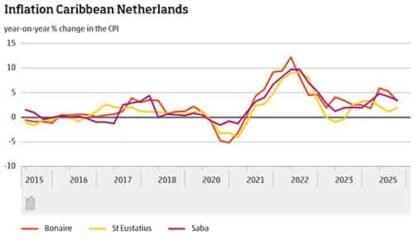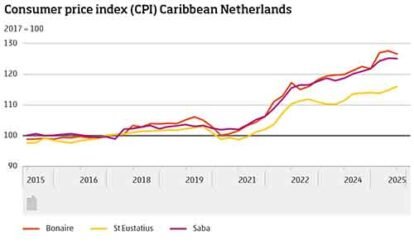In the third quarter of 2025, consumer goods and services on Bonaire were 3.3 percent more expensive year-on-year. In Q2, inflation was 5.3 percent. Statistics Netherlands (CBS) reports this on the basis of the consumer price index for the Caribbean Netherlands.
Prices on Saba in Q3 were up 3.5 percent compared with the same quarter last year, down from 4.2 percent in Q2. Inflation on St Eustatius stood at 1.9 percent in Q3, compared with 1.1 percent in Q2.
 Prices on Bonaire down 0.8 percent quarter-on-quarter
Prices on Bonaire down 0.8 percent quarter-on-quarter
In Q3 2025, prices on Bonaire fell 0.8 percent compared with Q2 2025. This decrease was mainly due to prices for housing, water and energy, which fell 6.4 percent on average. Prices for water supply and electricity fell 29.0 percent and 6.9 percent, respectively. This decline resulted from the reintroduction of drinking water and energy subsidies in the third quarter, after they had been discontinued at the beginning of 2025.
Prices for food products and non-alcoholic beverages in Q3 were 1.6 percent higher than in Q2. Passenger transport by air became 12.8 percent more expensive.

Prices on Saba also decreased
On Saba, prices fell 0.1 percent in Q3 2025 compared with Q2 2025. This was mainly due to prices for housing, water and energy, which fell as they did on Bonaire. Electricity prices fell 11.3 percent as a result of the reintroduction of the energy subsidy, while prices for water supply fell 10.6 percent.
Prices for clothing and footwear increased 3.2 percent compared with Q2, particularly for children’s and women’s clothing and men’s trousers. Prices for food products and non-alcoholic beverages rose 1.2 percent, mainly due to higher prices for fresh vegetables.
Prices on St Eustatius up 1.0 percent quarter-on-quarter
On St Eustatius, consumer prices rose 1.0 percent in Q3 compared with Q2. Clothing and footwear became 3.4 percent more expensive. As on Saba, the largest price increases were seen in women’s and children’s clothing, men’s trousers and men’s shoes. Food products and non-alcoholic beverages were 1.2 percent more expensive, mainly due to higher prices for fresh fruit and vegetables.
Water and electricity became cheaper compared with Q2. As on Bonaire, this was caused by the reintroduction of drinking water and energy subsidies, which had been discontinued earlier this year.
CBS

 Saba News News and Information from Saba Island, Dutch Caribbean
Saba News News and Information from Saba Island, Dutch Caribbean
